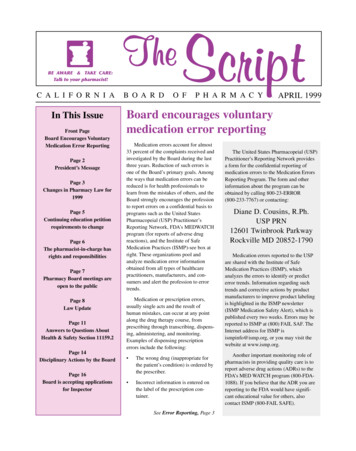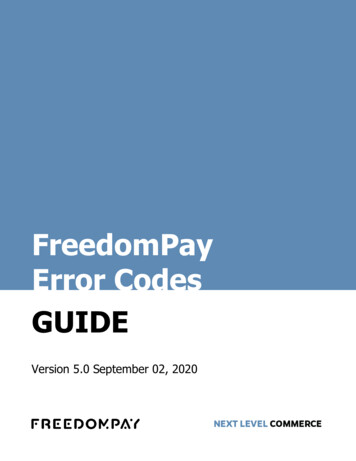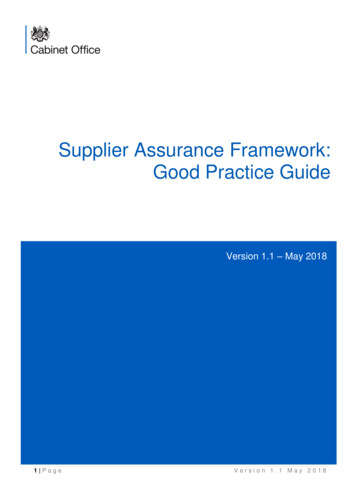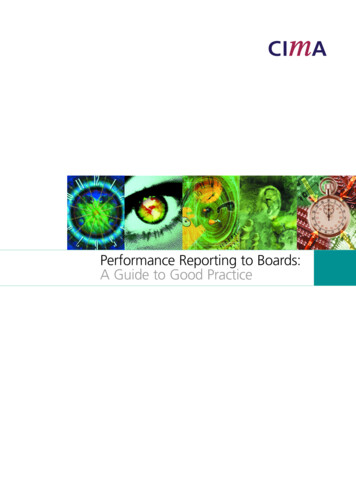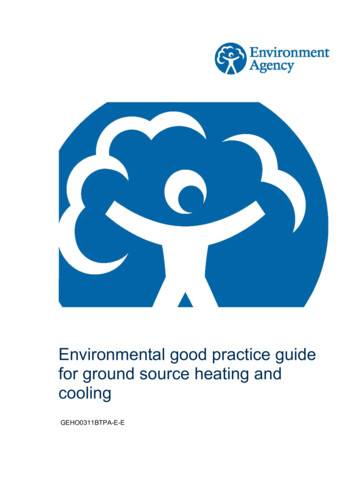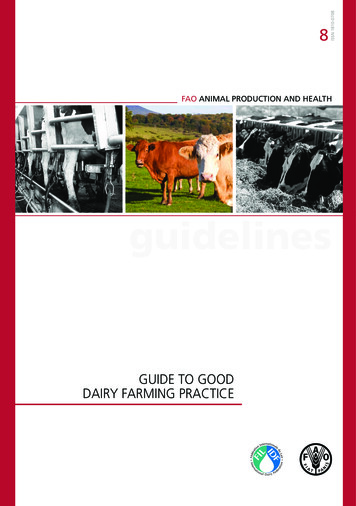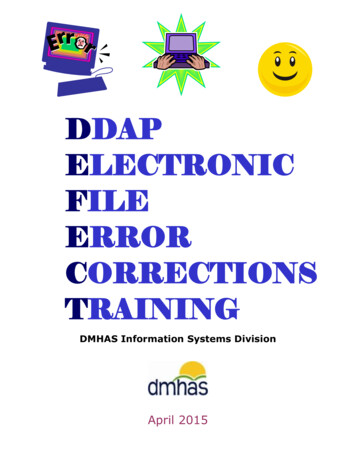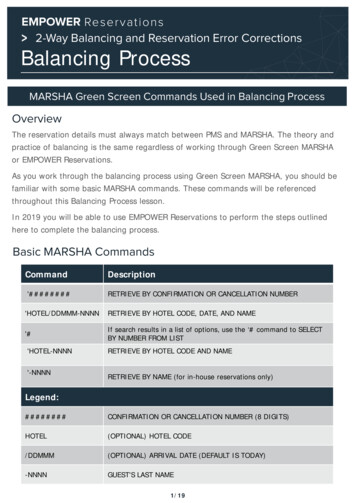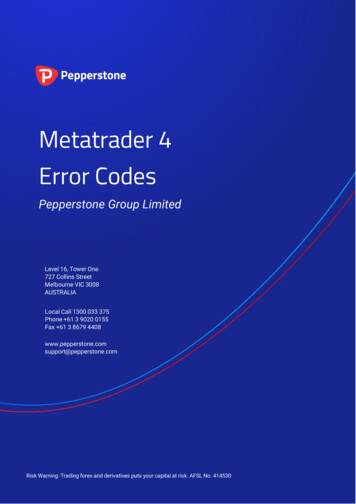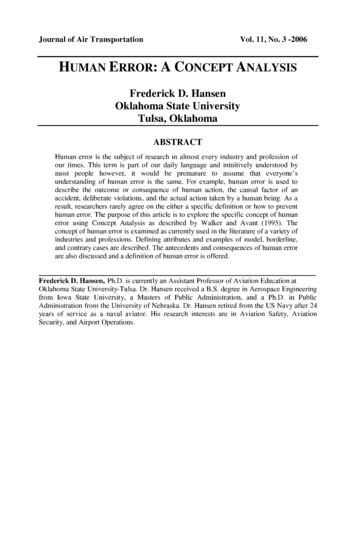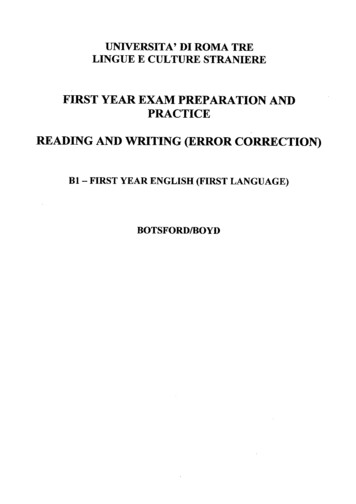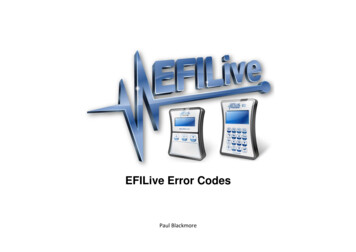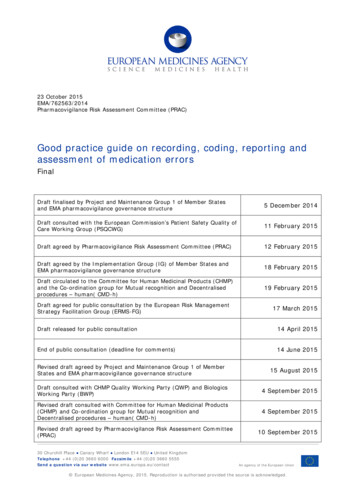
Transcription
23 October 2015EMA/762563/2014Pharmacovigilance Risk Assessment Committee (PRAC)Good practice guide on recording, coding, reporting andassessment of medication errorsFinalDraft finalised by Project and Maintenance Group 1 of Member Statesand EMA pharmacovigilance governance structure5 December 2014Draft consulted with the European Commission’s Patient Safety Quality ofCare Working Group (PSQCWG)11 February 2015Draft agreed by Pharmacovigilance Risk Assessment Committee (PRAC)12 February 2015Draft agreed by the Implementation Group (IG) of Member States andEMA pharmacovigilance governance structure18 February 2015Draft circulated to the Committee for Human Medicinal Products (CHMP)and the Co-ordination group for Mutual recognition and Decentralisedprocedures – human( CMD-h)19 February 2015Draft agreed for public consultation by the European Risk ManagementStrategy Facilitation Group (ERMS-FG)17 March 2015Draft released for public consultation14 April 2015End of public consultation (deadline for comments)14 June 2015Revised draft agreed by Project and Maintenance Group 1 of MemberStates and EMA pharmacovigilance governance structure15 August 2015Draft consulted with CHMP Quality Working Party (QWP) and BiologicsWorking Party (BWP)4 September 2015Revised draft consulted with Committee for Human Medicinal Products(CHMP) and Co-ordination group for Mutual recognition andDecentralised procedures – human( CMD-h)4 September 2015Revised draft agreed by Pharmacovigilance Risk Assessment Committee(PRAC)30 Churchill Place Canary Wharf London E14 5EU United KingdomTelephone 44 (0)20 3660 6000 Facsimile 44 (0)20 3660 5555Send a question via our website www.ema.europa.eu/contact10 September 2015An agency of the European Union European Medicines Agency, 2015. Reproduction is authorised provided the source is acknowledged.
Revised draft agreed by the Implementation Group (IG) of MemberStates and EMA pharmacovigilance governance structureRevised draft consulted with the European Commission’s Patient SafetyQuality of Care Working Group (PSQCWG)14 September 20155 October 2015Revised draft endorsed by the European Risk Management StrategyFacilitation Group (ERMS-FG)12 October 2015Revised draft adopted by Heads of Medicines Agencies (HMA)23 October 2015Final guidance published (date of coming into effect)Keywords27 November 2015Medication errors, pharmacovigilance, good practice, ICSR reporting,intercepted error, potential error, adverse reaction, MedDRA coding, PSUR,RMP, patient safety;Good practice guide on recording, coding, reporting and assessment of medication errorsEMA/762563/2014Page 2/42
Good practice guide on recording, coding, reporting andassessment of medication errorsTable of contentsExecutive summary . 51. Introduction . 52. Scope. 53. Legal basis . 64. Definitions . 74.1. Adverse event . 84.2. Adverse reaction . 84.3. Medication error . 84.3.1. Medication errors and correlation with harm and preventability . 94.3.2. Classification of medication error reports . 94.3.3. Intercepted medication error (‘near miss’) . 104.3.4. Potential medication error . 104.4. Patient safety incident. 114.5. Root cause analysis . 115. Structure and processes . 125.1. Recording of medication error reports . 125.2. Coding medication error reports . 145.2.1. Coding with Medical Dictionary for Regulatory Activities (MedDRA) . 145.2.2. General coding principles and MedDRA term selection . 155.2.3. Concept descriptions relevant for coding medication errors . 155.2.4. Medicinal product unavailability versus medication error . 165.2.5. Accidental and occupational exposures versus medication error . 175.2.6. Off-label use versus medication error and misuse . 175.2.7. Overdose/underdose versus medication error . 175.2.8. Product quality issues versus medication errors . 185.2.9. Coding of medication errors in context of drug delivery devices . 185.2.10. Standardised MedDRA Query for medication errors . 185.3. Reporting requirements for medication errors associated with adverse reactions . 195.3.1. Medication errors related to (invented) names . 215.3.2. Medication error reporting as emerging safety issue. 215.4. Periodic reporting of medication errors without adverse reaction(s) . 215.5. Follow-up of medication error reports . 235.5.1. Parameters to follow up when reporting medication errors . 235.5.2. ICH E2B (R3) ‘Additional information on drug’ data element. 285.6. Rules of anonymisation of personal data . 285.6.1. Healthcare professional reporting . 29Good practice guide on recording, coding, reporting and assessment of medication errorsEMA/762563/2014Page 3/42
5.6.2. Potential liability aspects . 296. Operation of the EU regulatory network . 306.1. The role of competent authorities in EU Member States . 306.1.1. Collaboration with national patient safety organisations . 306.2. The role of the Agency’s Pharmacovigilance Risk Assessment Committee . 326.3. The role of healthcare professionals, patients and consumers . 326.4. The role of marketing authorisation holders . 33List of acronyms . 34Annexes . 35Annex 1 - Simplified reporting rules for medication errors associated with adverse reactionspost EudraVigilance audit . 35Annex 2 - Templates for summary tabulation and listing of individual cases of medicationerrors . 36Annex 3 - Additional coding examples for medication errors . 38Annex 4 - Business process proposal for using ICH E2B (R3) for recording medication errorsin ICSRs . 42Good practice guide on recording, coding, reporting and assessment of medication errorsEMA/762563/2014Page 4/42
Executive summaryThe European Union (EU) pharmacovigilance legislation has introduced a number of changes related tomedication errors which affect the operation of pharmacovigilance systems in EU Member States. Tosupport implementation of the new legal provisions amongst the stakeholders involved in thereporting, evaluation and prevention of medication errors the European Medicines Agency (EMA) wasmandated to develop in collaboration with the EU regulatory network specific guidance for medicationerrors, taking into account the recommendations of a stakeholder workshop held in London in 2013.This good practice guide is a key deliverable of the EU regulatory network’s medication error initiativeto improve reporting and learning from medication errors for the benefit of public health.1. IntroductionErrors associated with the use of medicinal products are a major public-health burden and may happenwhen patients receive healthcare services for preventive, diagnostic, curative or rehabilitativepurposes. It has been estimated that 18.7 - 56% of all adverse events that occur among hospitalisedpatients result from medication errors that would be preventable. Medication errors are thus a concernat all stages of health care delivery in European health care systems 1.Medication errors occur as unintended mistakes in the process of prescribing, storing, dispensing,preparing or administering medicinal products in clinical practice. If a medication error occurs with thesame pattern or at an unacceptable frequency, or if it results in serious harm for the patient, it isessential to understand the causes, contributing factors and clinical consequences of the error, as wellas possible mitigating actions and solutions which could prevent the error from happening again.2. ScopeThe scope of this good practice guide includes the recording, coding, reporting and assessment ofmedication errors with medicinal products associated with suspected adverse reaction(s) in everydaymedical practice. This guide is therefore relevant to EU pharmacovigilance obligations applicable tocompetent authorities in EU Member States, marketing authorisation holders and the Agency.The primary purpose is to support competent authorities in EU Member States, marketing authorisationholders and the Agency to comply with their pharmacovigilance obligations detailed in Title IX ofDirective 2001/83/EC and Regulation (EC) 726/2004, Chapter 3, Article 28 with regard to therecording, reporting and assessment of suspected adverse reactions (serious and non-serious)associated with an error in prescribing, storing, dispensing, preparing for administration oradministering a medicinal product for human use authorised in the EU, regardless of the route ofauthorisation or the legal status of the medicinal product.The recording, coding, reporting and assessment of events associated with intentional overdose,abuse, misuse, occupational exposure, off-label use and of medication errors occurring in the contextof clinical trials conducted in accordance with Regulation (EU) No 536/2014, repealing Directive2001/20/EC, are outside the scope of this guidance.EU good pharmacovigilance practices (GVP) require marketing authorisation holders to summariseinformation on medication errors regardless of whether they are associated with adverse reaction(s) inperiodic safety update reports (PSUR) and to reflect the current knowledge about the risk ofmedication errors in risk management plans (RMP) for the purpose of continuous benefit-risk1von Laue NC, Schwappach DL, Koeck CM. The epidemiology of preventable adverse drug events: a review of theliterature. Wien Klin Wochenschr 2003; 115:407–415.Good practice guide on recording, coding, reporting and assessment of medication errorsEMA/762563/2014Page 5/42
evaluation of medicinal products. This guide therefore also provides recommendations for marketingauthorisation holders for recording, coding, reporting and assessment of medication errors brought totheir attention (e.g. through direct patient or healthcare professional reporting) which are notassociated with adverse reaction(s).The scope of this guide also includes coding of medication error reports based on the MedicalDictionary for Regulatory Activities (MedDRA) term selection recommendations in the context of EUpharmacovigilance obligations. Specific coding examples are provided in addition to the guidance of theMedDRA Term Selection Points to Consider (MTS:PTC) document.The guidance acknowledges the fundamental role of patient safety incident reporting systems (seechapter 4.4.) established in several EU Member States to enhance patient safety by learning frompotential failures of the healthcare system, including from medication errors which do not result inadverse reaction(s). However, the authorities, bodies, organisations and/or institutions responsible forpatient safety incident reporting in EU Member States are outside the remit of Directive 2001/83/ECand Regulation (EC) No 726/2004 and medication errors not associated with adverse reaction(s) arenot required to be reported as individual case safety reports (ICSR) in line with EU pharmacovigilanceobligations.In line with the provisions of Article 107a (5) of Directive 2001/83/EC one of the objectives of thisguidance is the establishment of good practice for sharing information on medication errors assoc
reporting, evaluation and prevention of medication errors the European Medicines Agency (EMA ) was mandated to develop in collaboration with the EU regulatory network specific guidance for medication errors, taking into account the recommendations of a stakeholder workshop held in London in 2013.
